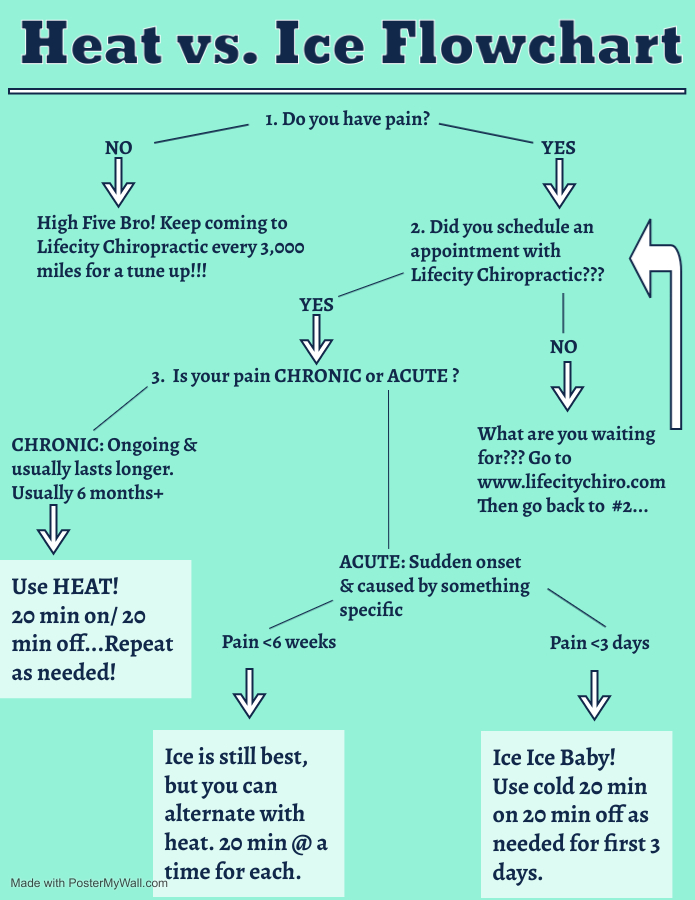When to Chill & When to Heat Things Up
Probably the most common home remedies for pain are the use of cold or heat, but which one should you use and when?
Cold Therapy
When using cold, or cryotherapy, it causes a constriction of blood vessels and as a result reduced blood flow to the affected area. By restricting blood flow to the affected area, it can significantly reduce inflammation and swelling that causes pain. It can also temporarily reduce nerve activity, which as an analgesic affect as well. Cold is best utilized on acute (first 72 hours) or sub-acute injuries.
Types of Cold Therapy
- Ice packs
- Gel packs
- Ice baths
- Ice massage
When Not to Use
- If you have poor circulation
- If you have stiff muscles or joints
- If you have any disease/disorder that prevents you from feeling cold, such as diabetes. This can prevent you from being able to tell if damage is being done.
Application
For new and acute injuries cold works best. Never place a frozen item directly on the skin. Use a layer of cloth or paper towel to prevent frostbite, especially when using a gel pack, as they reach colder temperatures than ice alone. Using cold should happen for short periods of time and repeat throughout the day. 3 sensations happen with cryotherapy. First it feels cold, then it becomes achy, then the area goes numb. It takes roughly 20 minutes to get to that point, therefore no more than 20 minutes of cold therapy should be used at one time to protect the skin and underlying tissue.
Risks of Cold
If applied too long or too directly cold can cause skin, tissue or nerve damage. If you have cardiovascular problems or heart disease consult your physician before utilizing cold therapy. If cold hasn’t helped with pain or swelling within 48 hours of use consult your doctor.
Heat Therapy
Using heat is best for chronic (old) injuries. Heat causes vasodilation or opening of the blood vessels and improves circulation and blood flow to affected area. Increasing the temperature can also reduce pain and increase muscle flexibility. It helps to relax and soothe tight muscles and promotes healing in damaged tissue.
Types of Heat
- Moist heat: Convection Heat – includes moist heating packs, steam rooms, hot baths and steamed towels.
- Dry heat: Conduction Heat – includes heating pads, dry hot packs and saunas
Professional forms of heat therapy can be used in certain settings where a trained professional is in control of the treatment. These include things like ultrasound or diathermy.
When Not to Use
- Over and open wound
- People with pre-existing conditions such as diabetes, dermatitis, blood clots (DVT), vascular disorders and multiple sclerosis (MS)
- If you have heart disease or hypertension
- Over bruising or swelling
Application
For old and chronic injuries heat works best. Just like with ice, never put hot packs or heating pads directly on the skin. Use 6 layers of paper towel or thin cloth to protect the skin and avoid burns.
Apply heat for 20 min at a time and repeat as needed with 20 minutes rest in between.
Risks of Heat
Using warm temperatures instead of hot temperatures can prevent you from burning your skin. If you have an infection, heat can speed up the spread of infection and should not be used on an infected area. Heating for longer than 20 minutes should not be done because it can cause pooling of inflammation in the affected area and can increase stiffness and soreness. If you experience swelling while using heat, stop immediately. If you’ve utilized heat therapy for more than a week with no relief or if your pain increases, consult your doctor.
In Conclusion
Knowing when to use heat and when to use cold will significantly increase the effectiveness of treatment. In certain situations, like arthritis, one may need to utilize both. The heat helps with joint stiffness and the cold helps with swelling and acute pain. If either treatment makes your condition worse, stop immediately. If you’re unsure, ask your healthcare provider. Here’s an Ice vs Heat flow chart to help you figure out which is best for you.

Is there a topic you’d like to learn more about? Please email us on blog topics you would like us to cover. We’re here to help keep you informed. info@lifecitychiro.com
Like and follow us on Facebook! Accepting new patients!
